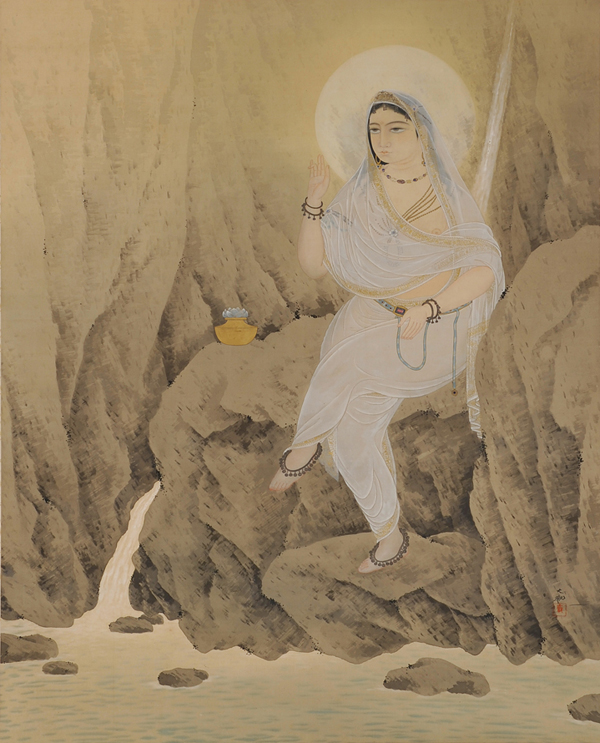Watch, Read, Listen
Recent Additions to the Collection MOMAT Collection Newsletter of the National Museum of Modern Art, Tokyo Yokoyama Taikan, Kannon in White, 1908
Back
Kannon in White
1908
Color on silk, hanging scroll
140.3 x 113.0cm
Purchased FY2018
Kannon in White, newly presented at last year’s exhibition The 150th Anniversary of his Birth: Yokoyama Taikan, has now been added to the collection. The whereabouts of this work had been unknown after it was reproduced in Taikan gashu (Paintings of Taikan), published in 1912. On the lid of a scroll box associated with the work is an inscription reading “By the brush of Taikan, a spring day, 1908.”
The date of 1908 makes sense in light of the work’s style. Taikan had traveled to India five years earlier, in 1903, with his associate Hishida Shunso. Though he stayed for less than half a year, Taikan subsequently incorporated Indian stylistic elements into his Buddhist-themed works for several years, including sari-like costumes, splendid jewelry, long bow-shaped eyebrows, large double-lidded eyes, and narrow, prominent noses. The artist’s fixation on “exotic” facial features had already faded by the time of The Floating Lantern (collection of the Museum of Modern Art, Ibaraki), dating from 1909, thus it makes sense that Kannon in White, in which this flavor remains strong, dates from a year and a half earlier than The Floating Lantern.
If there were any doubt regarding the work’s date, it would be about who might have commissioned such a large work from Taikan at this time. This was over a year after Taikan moved to Izura, Ibaraki Prefecture following the relocation of Nihon Bijutsuin (the Japan Art Institute), and he was still there in spring 1908. Few if any art dealers came to buy paintings from Taikan while he was in Izura.
Here we should note the name of Morimoto Rokubei, listed as an owner of the above-mentioned Taikan gashu collection of works. This man ran a brewery and a warehousing business in Kobe, eventually becoming a devout Buddhist and handing over his family business to his successor. He also went by the name Zuimei. The “zui” was evidently borrowed from Otani Kozui, the Buddhist abbot known for leading exploratory expeditions to Asia, and the name Zuimei is seen here and there in early 20th-century historical records in relation to Kozui and to his brother Otani Sonyu.
One of Taikan’s motivations for going to India was probably his ambition to capture something of the primal sources of Japanese art there, and to breathe new life into art with Buddhist themes. Meanwhile, Otani Kozui traveled to India in search of the origins of Buddhism, and Morimoto Zuimei was a great admirer of Otani’s. It seems that Morimoto may have directly commissioned from Taikan a representation of Kannon wearing a sari, but at this point it is still unclear.
In terms of points of contact between Taikan and Zuimei, we can cite the latter’s introduction of the artist to Murakami Kagaku, who had recently enrolled at the Kyoto Prefectural School of Painting in autumn 1911, and a single record of a painting commission from Zuimei in the artist’s “record of painting commissions” (collection of Yokoyama Taikan Memorial Hall), which lists these commissions from 1925 through 1957. These are intriguing clues for further investigation.
(Gendai no me, Newsletter of The National Museum of Modern Art, Tokyo No.632)
Release date :


